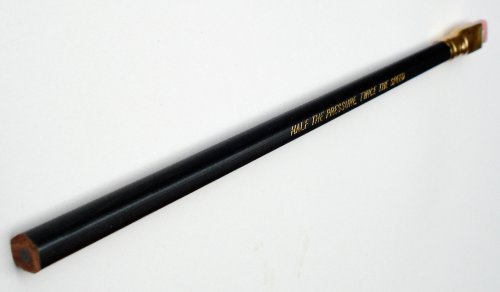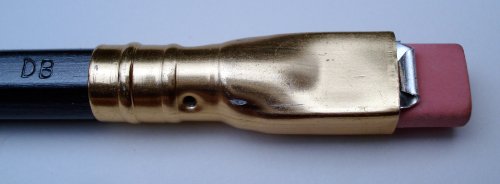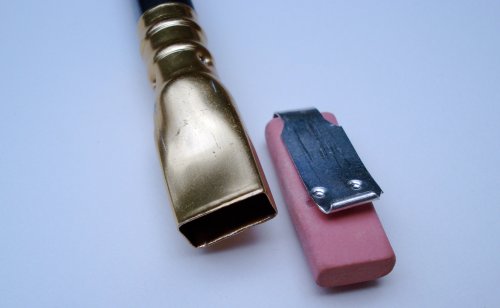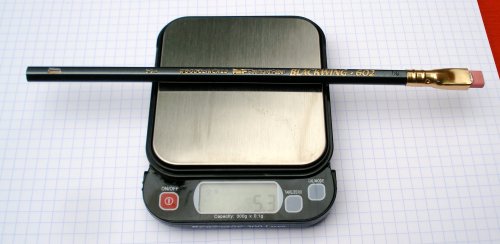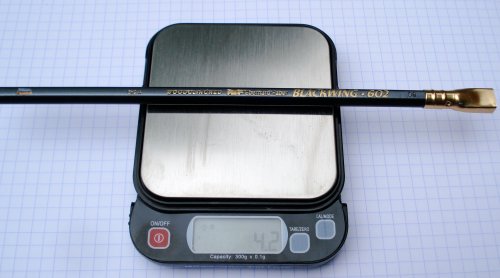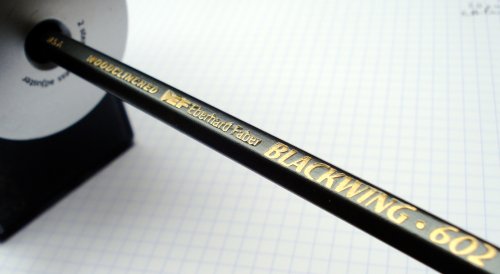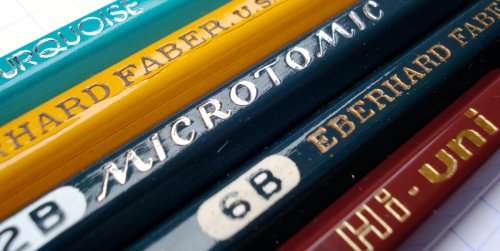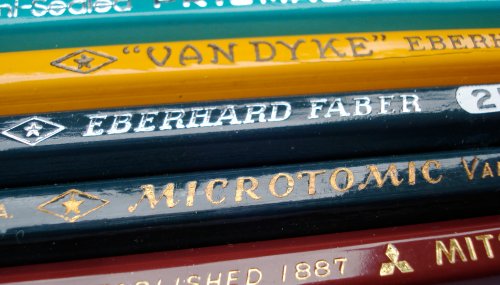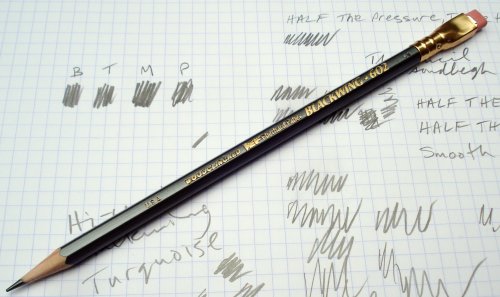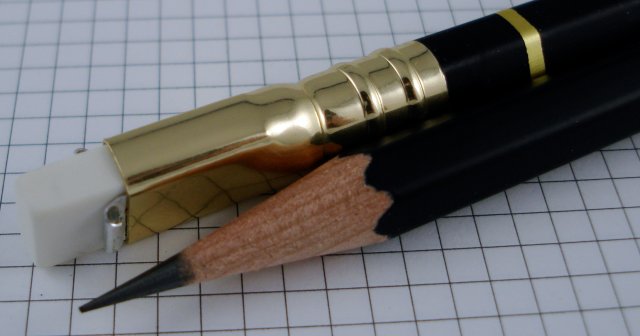
In July 2009, pencil aficionado extraordinaire Adair commented at this blog, “I wish that the visionary leader at Palomino would buy the rights to the Blackwing and come out with a contemporary version of it.”
Out of curiosity, I took a look at the US Patent and Trademark website, and saw that CalCeder had applied to register the expired Blackwing trademark. I replied: “Sanford has let the Blackwing trademark expire (it was registered by Eberhard Faber in 1934) – and CalCedar has applied for the name – though they don’t yet have the registration. There may in fact soon be a CalCedar Blackwing!”
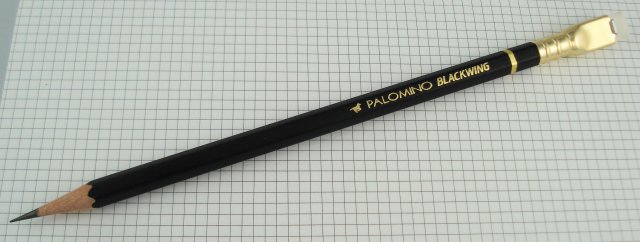
The cat was out of the bag. A subsequent email conversation with CalCedar revealed that this observation regarding the trademark was correct, and that it had become an idea in motion, with CalCedar contemplating the release of a new Blackwing!
For those not familiar with CalCedar, they are a major firm in the pencil industry infrastructure, harvesting cedar logs in California and Oregon, and processing the logs into pencil slats at their factory in Tianjin, China. They also process and sell Basswood slats.
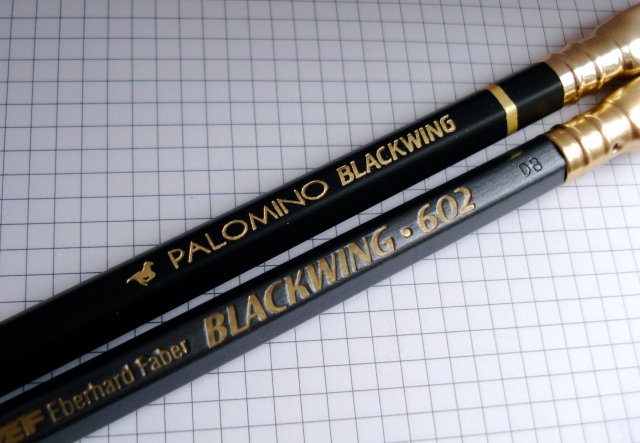
The Blackwing, if you are reading this post, may need even less introduction. Please see pencil talk‘s review, and especially, the amazing Blackwing Pages. I appreciate some recent links to the pencil talk review, particularly from Mark Frauenfelder at BoingBoing and Jenny Larew at The Blackwing Diaries. I especially appreciate Jenny’s link as her November 2005 post on the origin of her blog’s title (and I’ll note, that was the same month I started this blog) was, along with Henry Petroski’s The Pencil and a 2002 Boston Globe article, one of the major sources of fuel for the ongoing excitement over this pencil.
Fast forward to the present, and we have CalCedar announcing the release of a pre-production pencil to a limited audience, with reactions solicited.
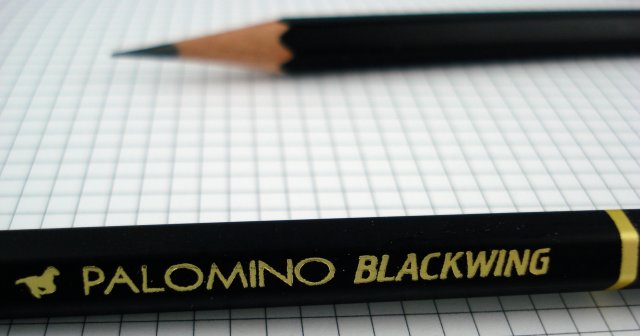
(Let me step aside from the review and say congratulations. Well done, Charles and company! Introducing a pencil in 2010 can not be easy, and we wish you well!)
There are always challenges with remakes, tributes, and reinterpretations. Did you see the recent US version of The Prisoner? Have you ever heard a bad tribute band? We hope this pencil will be a moment of triumph rather than a parody.
In many tests that I’ve participated in – alpha, beta, and undesignated – of various “hi-tech” products, the tester typically has a good idea of the product’s aims/goals/features, and possibly even support materials such as manuals, detailed specifications, and release notes regarding the object of testing.
Here, all we know is that the pencil is “pre-production”. So what does that mean? Unfortunately, not much.
My approach is to take two courses of evaluation – first, evaluate this pencil in comparison to the original, and second, to consider it as an evolved or next generation Blackwing. Both goals may have merit, though I doubt whether it would be possible to satisfactorily recreate a long defunct pencil. Equipment, wood sources, graphite core sources, paints, lacquers, glues and other materials have all changed over time. Paper as well. Further, I don’t think CalCedar has purchased any intellectual property such as formulae or machine specifications from Sanford.

I’ll also speculate, partly based on a questionnaire that accompanied the samples, that the pencil is basically finished, with only the exterior – final paint choices, packaging, and pricing – to be determined.
I’m also curious about the real magnitude of the Blackwing appeal. As regularly noted, the pencil failed in 1998. Word processing and software animation programs were already dominant then. In 2010, what will be the audience?
So on with the review!
Dimensions
While a sample original pencil weighed 5.3 grams, a new one is 6.5 grams. Hold on! This is a major surprise! This sample of one may not mean that much, as the wood in pencils can vary from specimen to specimen. Yet at about 20% heavier – I am wondering about what’s going on.
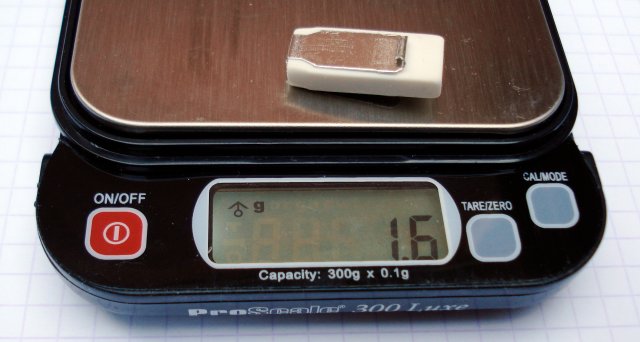
The size of the pencil is perhaps even more of a surprise – while the overall trend is for pencils to get narrower (cost savings from getting more pencils per slat), the new pencil is wider than the original! Just slightly – 7.25mm vs. 6.85mm measured side to opposite side – yet how interesting! It bodes well for the Palomino Blackwing to assume more traditional pencil proportions.
Appearance
Finish
The paint is matte black, rather like high end pencils from Pentel, Ohto, and Kita-Boshi. That is nice enough for aficionados, though I am worried that it will not succeed in the US market, accustomed to gloss finishes.
Lettering
The lettering is in gold, and simply shows the Palomino logo with the words “Palomino” and “Blackwing”. “Palomino” is in the style of the Palomino pencil, while “Blackwing” seems derived from the original. See the review at Orange Crate Art for a great discussion of the design, as well as the pencil as a whole.

There are also gold flecks all over the pencil, even on the opposite side of the pencil from the lettering.

This is the one aspect of this “pre-production” pencil that seems completely unacceptable for a product that aims to be in the top echelon. It looks like an amateur effort, and is poorly executed. Whether the aim is retro or modern, CalCedar need to engage the services of a professional graphic designer and employ the highest quality production techniques. (I’m sure some people reading this post would be capable!) Take a look at some of the designs coming from Faber-Castell or the top Japanese firms. The Blackwing needs to be in this company.
What may be equally important to some is that the original slogan, “Half the Pressure, Twice the Speed”, is absent.
Ferrule
The unique ferrule was part of the original’s essence, and is recreated in the new version. The newer version has a shinier surface, less of the bronze hue, and doesn’t show the crimp points of the original – i.e. it must be affixed by a continuous clamp process.
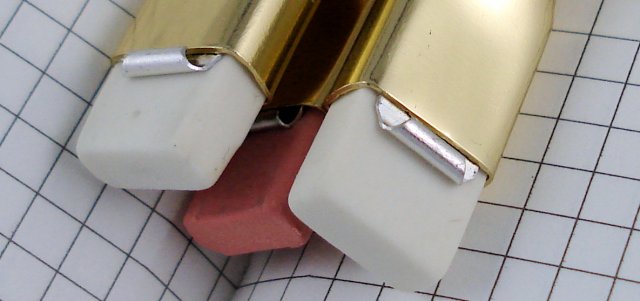
Eraser
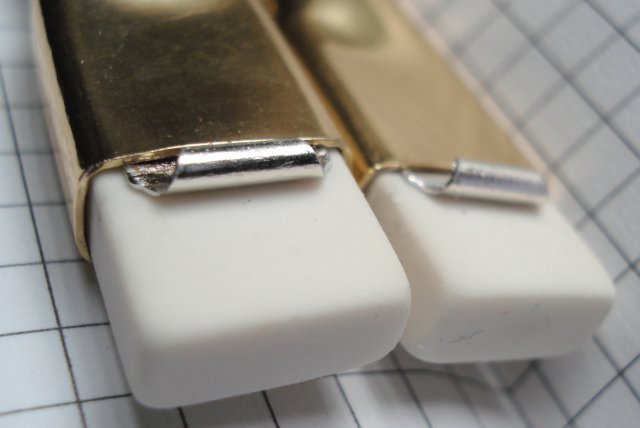
The eraser is white. Huh? Okay, this suggests that the pencil is the “Blackwing 2” rather than the “Blackwing 603”. Either could be fine, but the design needs to be clear. A modern vinyl eraser is a great idea, but the white/black/gold combination seems a bit off – how about a black eraser? I cut a trial piece to test:
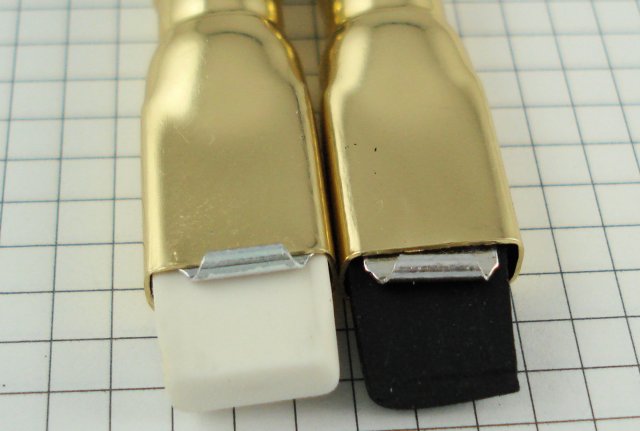
What do you think?
Writing
Darkness
The Palomino Blackwing lays down an exceptionally dark line. The challenge of pencil making is that as the graphite to clay ratio increases, the stability decreases. A 10B pencil, beautiful as the marks are, is extremely soft and decomposes quickly.
Apart from quick wear in a general sense, a specific issue with darker leads is crumbling. This is basic reason the regular Palomino isn’t considered to be as good as the top two Japanese pencils – the Palomino crumbles much more than the Hi-Uni and Mono 100.
Luminescence
Just as light bulbs emit heat as well as light, pencils emit luminescent, shiny markings apart from their dark markings.
On Strathmore 400 Series 218gsm black paper, I can’t say that I discerned any difference versus other pencils. Not that they didn’t exist, but if so, the difference was in degrees rather than magnitudes.
Smoothness
I have described the original Blackwing as beyond smooth, veering into being “slippery”. The Palomino Blackwing is less so. For me, that is fine and good. But I’m wondering if those hoping for a recreation of the original will be disappointed. It is still plenty smooth, the best in the business.
Keeping a point (wear)
Pencil aficionado Robert (of Taiwan), who has made many online contributions here and elsewhere, and who has sent me some very nice pencils including the Ohto 9000, has mentioned this aspect of pencils a few times.
Alas, an acute point does easily snap after being sharpened, and the point does rapidly wear down with use. This is a core aspect of the pencil that I doubt will change. If this is the premiere evaluation criterium for anyone, pencils from Faber-Castell, Tombow, or others may better suited.
Fastness
On a fantastic white coated paper like Clairefontaine, the Palomino Blackwing is a smear monster! Seriously, it exemplifies what some people hate about pencils in a way I’ve rarely witnesed. The marks become like finger paint. I don’t know why, but presumably something in the formula repels something in the Clairefontaine paper’s coating.
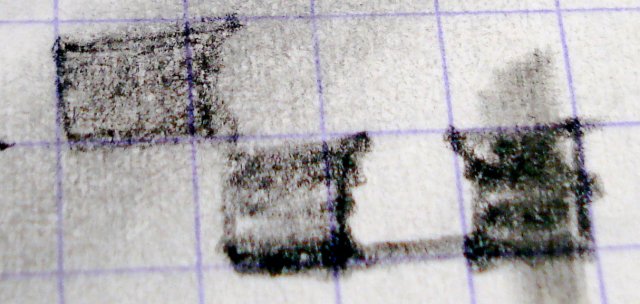
That is too bad, as I love using the great products from Clairefontaine and Rhodia with pencil. This result won’t stop me, but I’ll be more cautious.
On more fibrous paper. there is again some smearning, but at a more acceptable level.
Tests on Paper
I’ve tried the Blackwing on newsprint, office copy paper, and on looseleaf Clairefontaine paper, and cream coloured papers in typical Moleskine, Leuchtturm, Canteo, etc. journals.
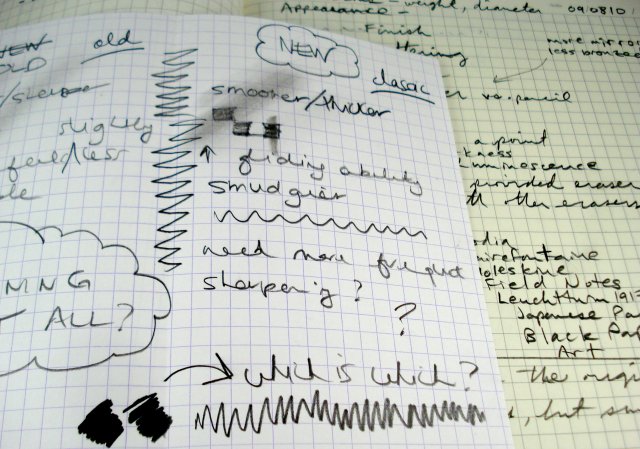
Crossword puzzle devotees may enjoy the dark lines of the Blackwing. Office copy paper is tuned for the high speed laser printer, but does well.
On the thicker cream coloured journal papers (Canteo in particular), the line was superb. It was also excellent on other such papers. As noted, coated papers produced more smearing, though the pencil lines still looked excellent. And looseleaf Clairefontaine paper fared a bit better than Clairefontaine journals for reasons unknown.
Basically, the Blackwing works with everything, and especially excels with thicker cream coloured paper.
Writing (Overall)
The Palomino Blackwing is excellent for cursive writing and note taking on many paper types. It is not the best for small mathematical notations or any task requiring a sharp point.
Other considerations
Aroma
Probably due to being fresh out of a factory, the pencils have a strong paint or chemical aroma. I’ll assume production pencils won’t have this issue.
Sharpening
Cedar typically sharpens well, and the Blackwing Palomino was no exception. CalCedar sent only two pencils, so the testing possibilities are limited here.
Erasability
Another downside to dark rich lines is that they are harder to erase. There is no exception here. The pencil’s own eraser, and other erasers such as the top tier Pilot Foam only do a so-so job on the Blackwing’s lines.
I’d like to thank CalCedar for the pencil samples.
I said there were two courses of evaluation for this product. After using the prototype, I see the Palomino Blackwing as being too different from the original Eberhard Faber Blackwing 602 in appearance and graphite function to be considered a clone or reissue. Rather, it is a modern interpretation – and a very fine one indeed.
[Update: September 15, 2010]
I feel uncomfortable about having inadvertently misled the readers of this blog about just what was being reviewed in this post.
A statement from CalCedar confirms that these are not “pre-production” pencils at all – they are in every sense “production” pencils that will soon be for sale. As well, we are told that the questionnaire that accompanied the pencils will be used to inform a possible second version of the pencil.
It all makes no sense to me – I believe the same level of enthusiasm would have been shown, and the same amount of publicity garnered if CalCedar had just given reviewers the facts. While I’d like to believe that there was no intent to mislead, it seems absolutely implausible that these coordinated actions were all accidental or mistakes. The situation is so simple that it astounds me that trickery like this was felt necessary.















